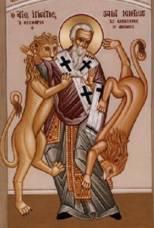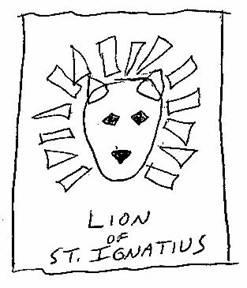Persecution: St. Ignatius of Antioch
PERSECUTIONS
 Objectives:
Objectives:
- Students should be able to say the word “persecution” and know its meaning.
- Students should be able to name St. Ignatius of Antioch and tell his story.
- Students should know that we were first called Christians in Antioch.
Possible Lesson Plan:
- Open with prayer.
- Read the story of St. Ignatius of Antioch as follows:
In the early days of the Church, it was dangerous to be a Christian. Many of the Emperors of Rome did not like Christians because they would not worship the gods of Rome and the Emperor himself. Do you remember the stories of the three young men in the fire and Daniel in the lion’s den? (Review them here.) Just like these men who loved God, early Christians were burned and eaten by lions. The Emperor Nero had made it illegal to just be a Christian; he burned the city of Rome and blamed the Christians, making people very angry. The Romans killed Christians only for believing in Jesus. People who are killed for what they believe are called martyrs.
By the year 100 AD, all of the apostles who had known Jesus personally were dead – most as martyrs. Do you remember how St. Peter died? But many of those who had known the apostles themselves were still alive. These men were called Apostolic Fathers. One of these was Ignatius, Bishop of Antioch, the city where Christians were first called Christians. St. Ignatius was a martyr. Here is his story:
As a young boy, Ignatius felt the Lord Jesus hug him and, from that day forward, he grew so close to the Lord in prayer that he became known as the "God-bearer". Ignatius had known the apostles when he was a young man. He was taught by the Evangelist John. He grew to become a priest and then Bishop of Antioch. As bishop he ordained more men as priests and deacons. The church in Antioch was growing and strong. Ignatius preached wisely to his people and was known as a just and fair man. Unfortunately, he was known also to the pagans, who thought that if they got rid of Ignatius the Church would crumble.
Their opportunity came when the Emperor Trajan had a great victory and ordered every citizen to give thanks to the idols of Rome. Ignatius would not sacrifice to the idols and taught the other Christians to worship only Christ Jesus. Ignatius was arrested and found guilty of being a Christian. The judge sentenced him to die in Rome. All along the way, guarded by two soldiers, the bishop was greeted by other Christians. He even met St. Polycarp while passing through Smyrna. (Travel with Ignatius from Antioch to Smyrna to Troas, and then to Rome on your map.) All along the way, Ignatius wrote letters to the churches in various cities, telling them to be strong in the Lord. We still have these letters. He was not afraid to die; he would be with Jesus. Finally, the good bishop reached Rome. There he was thrown to the lions in the arena – a martyr. But, even the lions did not touch the heart of the saint. After his death, many of the faithful saw Ignatius in their dreams, praying for the city of Rome. His courage caused the Emperor Trajan to stop persecuting Christians for the rest of his reign. St. Ignatius of Antioch is remembered by the Church on February 1 each year.
- Review the role of bishop, priest, and deacon. You remember that in the earliest days of the Church in Jerusalem the apostles appointed deacons to help them in the day-to-day running of the Church affairs. By the time of St. Ignatius, we can tell from his writings that the Church even in 100 AD already had the structure that it holds to this day. Each city had a bishop, responsible to God for the welfare of the entire Christian community of that city. These bishops were ordained by the apostles themselves, or bishops ordained by the apostles. The bishops ordained priests to care for each individual church. And deacons continued to help the priests in the daily affairs of the church. Ignatius was particularly concerned with the unity of the Church in the world and in each city.
- Play a Learning Game: Word Jumble – What are the answers to these questions:
I burned Rome and blamed the Christians. RENO
Christians were first called by this name here. TICHONA
I was bishop of Antioch in 100 AD. STAGUINI
I met Ignatius in Smyrna on his way to Rome. RACPOPLY
I was the city where Ignatius died. MERO
I killed Ignatius. NILO
 Make St. Ignatius’s lion: Take a piece of wax paper. Cut an oval out of gold or yellow tissue paper. Cut two yellow or told ears. Cut out 2 black eyes and a black nose. Cut some smaller rectangles and long, thin triangles of different shades of brown tissue paper. Now arrange all as a lion with a mane on the wax paper. Cover with another piece of wax paper. Iron on low; wax papers will fuse. Trim edges and add title, “Lion of St. Ignatius”. No iron or electricity? Use clear adhesive self-lamination sheets.
Make St. Ignatius’s lion: Take a piece of wax paper. Cut an oval out of gold or yellow tissue paper. Cut two yellow or told ears. Cut out 2 black eyes and a black nose. Cut some smaller rectangles and long, thin triangles of different shades of brown tissue paper. Now arrange all as a lion with a mane on the wax paper. Cover with another piece of wax paper. Iron on low; wax papers will fuse. Trim edges and add title, “Lion of St. Ignatius”. No iron or electricity? Use clear adhesive self-lamination sheets.
- Close with Prayer: Lord, help me to love You as much as did Ignatius.